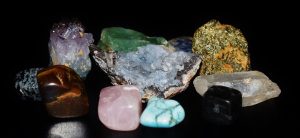Volcanic activity is a powerful force that can dramatically shape our planet’s landscape. One lesser-known effect of volcanic activity is its ability to create some of the world’s most beautiful and valuable gemstones. When molten rock or magma cools and solidifies, it can form a variety of gemstones. Volcanic activity can also create the high temperatures and pressures needed to form gems from existing minerals. As a result, volcanic areas are a rich source of gems, ranging from the familiar to the exotic.
Obsidian
Obsidian is a naturally occurring volcanic glass that is formed when lava cools quickly, preventing the formation of crystals. This process creates a smooth, glossy, and often black glassy material that can be used for decorative and functional purposes. Obsidian can also come in other colors, including brown, gray, and green.
The formation process of obsidian begins when magma rises to the Earth’s surface during a volcanic eruption. As the magma cools rapidly, it solidifies into a glassy substance. Obsidian is typically found near the volcanic vent or along the edges of lava flows.
One of the unique characteristics of obsidian is its conchoidal fracture, which means that when it is broken, it fractures into curved shapes like a shell. This characteristic is useful for creating sharp edges and tools, and ancient peoples used obsidian for weapons, such as knives and arrowheads.
Today, obsidian is used for a variety of decorative and functional purposes. It is often cut and polished into beads, cabochons, and sculptures for jewelry and art pieces. Due to its glass-like appearance and its sharpness when fractured, obsidian is also used in surgical scalpels and in scientific instruments for high-precision cutting.
In addition to its practical uses, obsidian is also valued for its unique beauty. Its smooth, glassy surface can be polished to a high shine, and its dark color contrasts with other gemstones. Whether used for functional or decorative purposes, obsidian remains an important and versatile gemstone prized for centuries.
Peridot
Peridot is a beautiful green gemstone that is formed from volcanic activity. It is a mineral called olivine that is rich in iron and magnesium. The green color of the peridot comes from the presence of iron in the crystal structure.
The formation process of peridot begins deep within the Earth’s mantle, where high temperatures and pressures create the conditions for the formation of olivine. During a volcanic eruption, magma from the mantle is brought to the surface, and as it cools, peridot crystals can form. These crystals are often found in basaltic lava flows and can also be found in some meteorites.
Peridot has a number of unique characteristics that make it a popular gemstone. It has a bright, vibrant green color that is often compared to the green of new growth in nature. It is also a relatively hard gemstone, with a Mohs hardness of 6.5 to 7, making it durable enough for everyday wear.
Peridot is used in a variety of jewelry designs, from rings and necklaces to earrings and bracelets. Its bright green color makes it a popular choice for statement pieces, and it is often paired with other gemstones, such as diamonds and sapphires, to create a more dramatic effect. In addition to its beauty, peridot is also believed to have healing properties and is thought to bring peace, happiness, and good fortune to its wearer.
Overall, peridot is a unique and beautiful gemstone prized for its vivid green color and durability. Its origins in volcanic activity make it all the more fascinating and valuable to collectors and gemstone enthusiasts.
 Amethyst
Amethyst
Amethyst is a violet variety of quartz that is found in volcanic rocks. The purple color of amethyst is caused by the presence of iron impurities in the quartz crystal lattice. Amethyst can be found in a range of shades, from pale lilac to deep violet.
The formation process of amethyst begins deep within the Earth’s crust, where magma and hydrothermal fluids create the conditions for the formation of quartz crystals. When these fluids cool and solidify, they leave behind veins of quartz that may contain amethyst. These veins can be found in a variety of rocks, including volcanic rocks, granites, and gneisses.
One of the most distinctive characteristics of amethyst is its transparency. When cut and polished, it has a brilliant, glassy shine, making it a popular jewelry gemstone. Amethyst is also a relatively hard mineral, with a Mohs hardness of 7, making it durable enough for everyday wear.
Amethyst has been used for jewelry and decorative purposes for thousands of years. In ancient times, it was believed to have healing properties and was often worn as an amulet to ward off evil spirits. Amethyst is still used in jewelry designs and is a popular choice for engagement rings, earrings, and necklaces. It is also used in a variety of decorative items, including vases, sculptures, and bookends.
In addition to its beauty, amethyst is believed to have a number of spiritual and healing properties. It promotes clarity of thought, enhances intuition, and relieves stress and anxiety. Overall, amethyst is a versatile and stunning gemstone valued for its physical and metaphysical properties.
Opal
Opal is a unique and colorful gemstone that is formed in volcanic rock formations. It is a mineraloid that is made up of tiny spheres of silica, which diffract light to create a stunning array of colors. Opal can be found in various colors, including white, black, blue, pink, and green.
The formation process of opal begins when silica-rich fluids seep into volcanic rocks, such as basalt and rhyolite. Over time, the fluids evaporate and leave behind tiny silica spheres arranged in a three-dimensional lattice structure. When light enters the lattice, it is diffracted and scattered, creating the play of color that is characteristic of opal.
One of the unique characteristics of opal is its iridescence. The play of color in opal can range from subtle flashes to intense bursts of color and can vary depending on the angle of the light and the stone’s orientation. Opal is also a relatively soft gemstone, with a Mohs hardness of 5.5 to 6.5, making it less durable than other gemstones.
Opal is used in a variety of jewelry designs, including rings, necklaces, and earrings. It is often paired with other gemstones, such as diamonds and sapphires, to create a more striking effect. In addition to its use in jewelry, opal is also used in decorative items, such as vases and sculptures.
Opal is believed to have a number of metaphysical properties. It is said to enhance creativity, intuition, and emotional balance and is also associated with love and passion. Opal is also considered to be a stone of transformation and is said to help its wearer navigate through changes and transitions in life.
Garnet
Garnet is a group of minerals found in various colors, including red, orange, yellow, green, and purple. It is often found in metamorphic rocks that are associated with volcanic activity, such as schist and gneiss. Garnet is a hard and durable gemstone with a Mohs hardness of 6.5 to 7.5.
The formation process of garnet begins when minerals such as aluminum, calcium, and iron are subjected to high temperatures and pressure. This process can occur in a variety of settings, including volcanic activity and mountain-building processes. As the minerals are subjected to these extreme conditions, they recrystallize and form garnet crystals.
One of the most distinctive characteristics of garnet is its color. Garnet can be found in a wide range of hues, from deep red to bright green. Some types of garnet, such as the red variety known as almandine, are particularly prized for their intense color and clarity.
Garnet is used in a variety of jewelry designs, including rings, necklaces, and earrings. It is often cut into faceted shapes to enhance its brilliance and color. Garnet is also used in a variety of industrial applications, including abrasive blasting, water filtration, and cutting tools.
In addition to its physical properties, garnet is believed to have a number of metaphysical properties. It is said to promote vitality, courage, and passion and is often associated with the root chakra. Garnet is also said to have a grounding and stabilizing effect, helping its wearer to feel more centered and focused.
Overall, garnet is a versatile and beautiful gemstone that is prized for its unique color and durability. Its association with volcanic activity and metamorphic rocks adds to its value and appeal, making it a popular choice for both jewelry and industrial applications.
 Sapphires
Sapphires
Sapphires are corundum minerals found in a range of colors, including blue, pink, yellow, and green. They can be formed from volcanic rocks, as well as in metamorphic rocks associated with volcanic activity.
The formation process of sapphires begins with aluminum and oxygen-rich fluids that are often associated with magma. These fluids can be found in the cracks and crevices of volcanic rocks and are heated by magma. As the fluids cool, they deposit aluminum and oxygen-rich minerals, including corundum, which can crystallize into sapphires.
One of the most distinctive characteristics of sapphires is their color. Blue sapphires are particularly prized for their intense hue, which is caused by the presence of trace amounts of iron and titanium. On the other hand, pink sapphires are caused by trace amounts of chromium.
Sapphires are a popular choice for jewelry, particularly engagement rings. They are also used in a variety of industrial applications, including the manufacture of watch crystals and electronics.
In addition to their physical properties, sapphires are believed to have a number of metaphysical properties. They are said to promote wisdom, truth, and mental clarity and are often associated with the third eye and throat chakras. Sapphires are also said to have a calming and soothing effect, helping their wearers to feel more centered and grounded.
Topaz
Topaz is a gemstone that can be found in a variety of colors, including yellow, pink, blue, and green. It is often formed in pegmatites, which are coarse-grained igneous rocks that are associated with volcanic activity.
The formation process of topaz begins when minerals such as aluminum, silicon, and fluorine are subjected to high temperatures and pressure. This process can occur in a variety of settings, including pegmatites and hydrothermal veins. As the minerals are subjected to these extreme conditions, they recrystallize and form topaz crystals.
One of the most distinctive characteristics of topaz is its color. Topaz can be found in a wide range of hues, from pale yellow to deep blue. Some types of topaz, such as the pink variety known as Imperial Topaz, are particularly prized for their intense color and clarity.
Topaz is used in a variety of jewelry designs, including rings, necklaces, and earrings. It is often cut into faceted shapes to enhance its brilliance and color. Topaz is also used in a variety of industrial applications, including optical coatings, abrasives, and electronics.
In addition to its physical properties, topaz is believed to have a number of metaphysical properties. It is said to promote clarity, truth, and emotional stability and is often associated with the throat and third eye chakras. Topaz is also said to have a calming and soothing effect, helping its wearer to feel more relaxed and focused.
Overall, topaz is a versatile and beautiful gemstone that is prized for its unique color and durability. Its association with pegmatites and volcanic activity adds to its value and appeal, making it a popular choice for both jewelry and industrial applications.
Zircon
Zircon is a gemstone that can be found in a range of colors, including blue, green, yellow, red, and brown. It is commonly found in volcanic rocks, as well as in sedimentary and metamorphic rocks associated with volcanic activity.
The formation process of zircon begins with the crystallization of magma, which can occur in the earth’s crust or mantle. As the magma cools and solidifies, it can incorporate zircon crystals that have been transported by volcanic activity. Zircon can also be formed from hydrothermal fluids that are associated with volcanic rocks.
One of the most distinctive characteristics of zircon is its high refractive index, which gives it a brilliant sparkle. It is also a relatively hard and durable gemstone, with a rating of 7.5 on the Mohs scale of mineral hardness.
Zircon is a popular gemstone for jewelry, particularly as an alternative to diamonds. Its wide range of colors makes it a versatile choice for a variety of styles and settings. In addition to its use in jewelry, zircon is also used in a number of industrial applications, including as a refractory material in furnace linings and as a ceramic pigment.
Zircon has also been used in spiritual and cultural practices for thousands of years. In Hindu astrology, zircon is associated with the planet Venus and is said to bring love and prosperity to its wearer. In ancient times, zircon was believed to have healing properties and was used to treat various ailments.
 So, What Gems come from Volcanoes?
So, What Gems come from Volcanoes?
Volcanic areas are known for their diverse and valuable gemstones that have been prized for centuries for their beauty and durability. Some of the most popular volcanic gemstones include obsidian, peridot, amethyst, opal, garnet, topaz, sapphires, and zircon.
These gemstones are formed through a range of processes, from the cooling and solidification of magma to the hydrothermal fluids associated with volcanic activity. They are valued not only for their beauty and durability but also for their symbolism, cultural significance, and spiritual properties.
The jewelry industry, in particular, relies heavily on volcanic gemstones for their unique characteristics and stunning colors. From engagement rings to statement pieces, volcanic gemstones offer a wide range of possibilities for jewelry designers and consumers alike.
In conclusion, the gems that come from volcanoes are not only beautiful and valuable, but they also offer a glimpse into the geological history of our planet. Whether you’re a jewelry enthusiast or simply fascinated by the natural world, the world of volcanic gemstones is one that is well worth exploring.
Want to whether Kay Jewelers’ diamonds are authentic? Read it here.


 Amethyst
Amethyst Sapphires
Sapphires So, What Gems come from Volcanoes?
So, What Gems come from Volcanoes?







